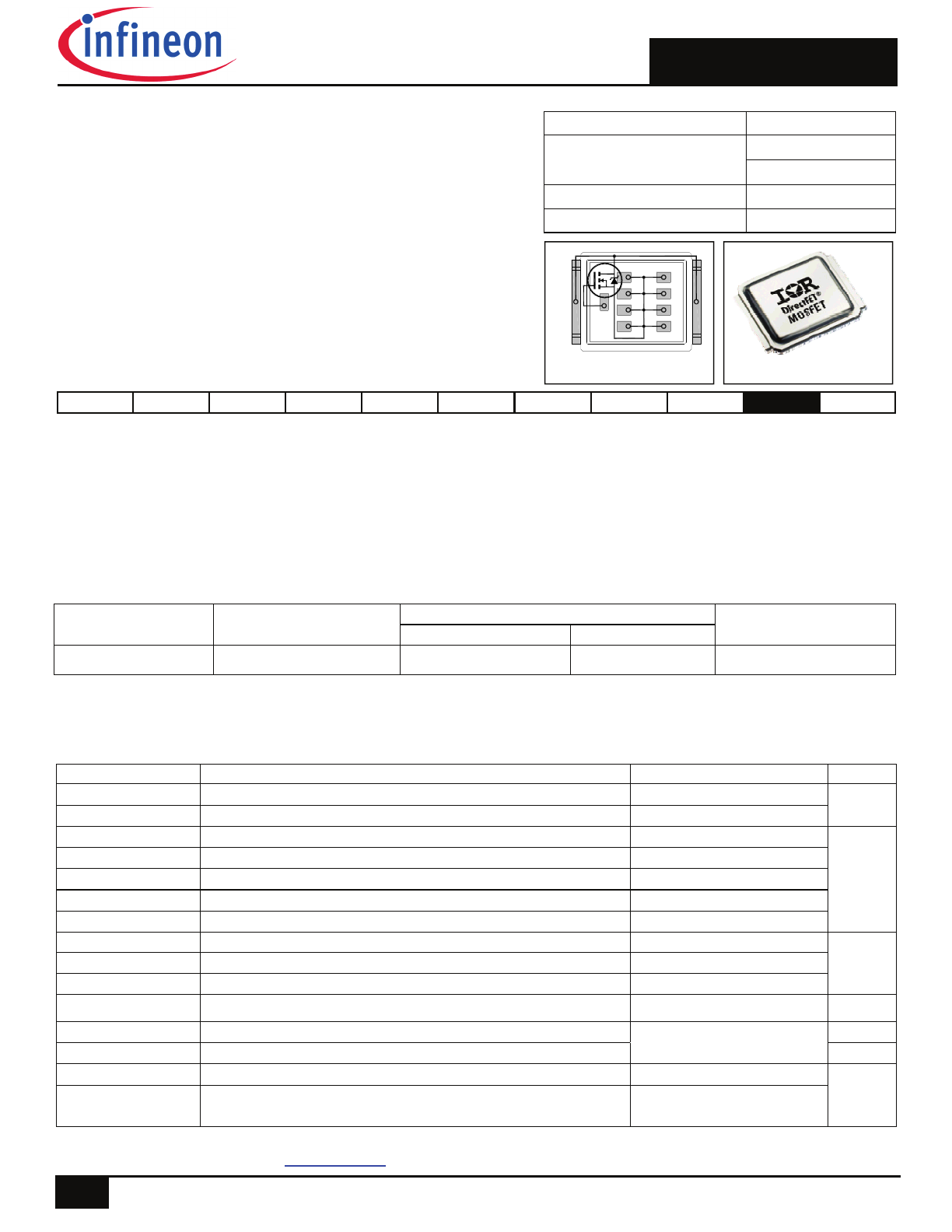
AUIRF7799L2TR
Base Part Number
Package Type
Standard Pack
Form Quantity
AUIRF7799L2
DirectFET Large Can
Tape and Reel
4000
AUIRF7799L2TR
Orderable Part Number
AUTOMOTIVE GRADE
V
(BR)DSS
250V
R
DS(on)
typ.
32m
I
D (Silicon Limited)
35A
max.
38m
Q
g (typical)
110nC
DirectFET
®
ISOMETRIC
L8
Automotive DirectFET
®
Power MOSFET
Applicable DirectFET
®
Outline and Substrate Outline
SB
SC
M2
M4
L4
L6
L8
Description
The AUIRF7799L2TR combines the latest Automotive HEXFET
®
Power MOSFET Silicon technology with the advanced DirectFET
®
packaging to
achieve the lowest on-state resistance in a package that has the footprint of a DPak (TO-252AA) and only 0.7 mm profile. The DirectFET
®
package is
compatible with existing layout geometries used in power applications, PCB assembly equipment and vapor phase, infra-red or convection soldering
techniques, when application note AN-1035 is followed regarding the manufacturing methods and processes. The DirectFET
®
package allows dual
sided cooling to maximize thermal transfer in automotive power systems.
This HEXFET
®
Power MOSFET is designed for applications where efficiency and power density are essential. The advanced DirectFET
®
packaging
platform coupled with the latest silicon technology allows the AUIRF7799L2TR to offer substantial system level savings and performance improvement
specifically in motor drive, high frequency DC-DC and other heavy load applications on ICE, HEV and EV platforms. This MOSFET utilizes the latest
processing techniques to achieve low on-resistance and low Qg per silicon area. Additional features of this MOSFET are 175°C operating junction
temperature and high repetitive peak current capability. These features combine to make this MOSFET a highly efficient, robust and reliable device for
high current automotive applications.
Absolute Maximum Ratings
Stresses beyond those listed under “Absolute Maximum Ratings” may cause permanent damage to the device. These are stress ratings only; and
functional operation of the device at these or any other condition beyond those indicated in the specifications is not implied. Exposure to absolute-
maximum-rated conditions for extended periods may affect device reliability. The thermal resistance and power dissipation ratings are measured under
board mounted and still air conditions. Ambient temperature (TA) is 25°C, unless otherwise specified.
Parameter Max.
Units
V
DS
Drain-to-Source Voltage
250
V
V
GS
Gate-to-Source Voltage
±30
I
D
@ T
C
= 25°C
Continuous Drain Current, V
GS
@ 10V (Silicon Limited) 35
A
I
D
@ T
C
= 100°C
Continuous Drain Current, V
GS
@ 10V (Silicon Limited) 25
I
D
@ T
A
= 25°C
Continuous Drain Current, V
GS
@ 10V (Silicon Limited) 6.6
I
D
@ T
C
= 25°C
Continuous Drain Current, V
GS
@ 10V (Package Limited)
375
I
DM
Pulsed Drain Current 140
P
D
@T
C
= 25°C
Power Dissipation 125
W
P
D
@T
A
= 25°C
Power Dissipation 4.3
E
AS
Single Pulse Avalanche Energy (Thermally Limited) 325
mJ
I
AR
Avalanche Current
See Fig. 16, 17, 18a, 18b
A
E
AR
Repetitive Avalanche Energy
mJ
T
P
Peak Soldering Temperature
270
°C
T
J
Operating Junction and
-55 to + 175
T
STG
Storage Temperature Range
P
D
@T
C
= 100°C
Power Dissipation 63
1
2015-10-5
HEXFET® is a registered trademark of Infineon.
*Qualification standards can be found at
www.infineon.com
Advanced Process Technology
Optimized for Automotive Motor Drive, DC-DC and
other Heavy Load Applications
Exceptionally Small Footprint and Low Profile
High Power Density
Low Parasitic Parameters
Dual Sided Cooling
175°C Operating Temperature
Repetitive Avalanche Capability for Robustness and Reliability
Lead free, RoHS and Halogen free
Automotive Qualified *
D
D
S
S
S
S
S
S
S
S
G
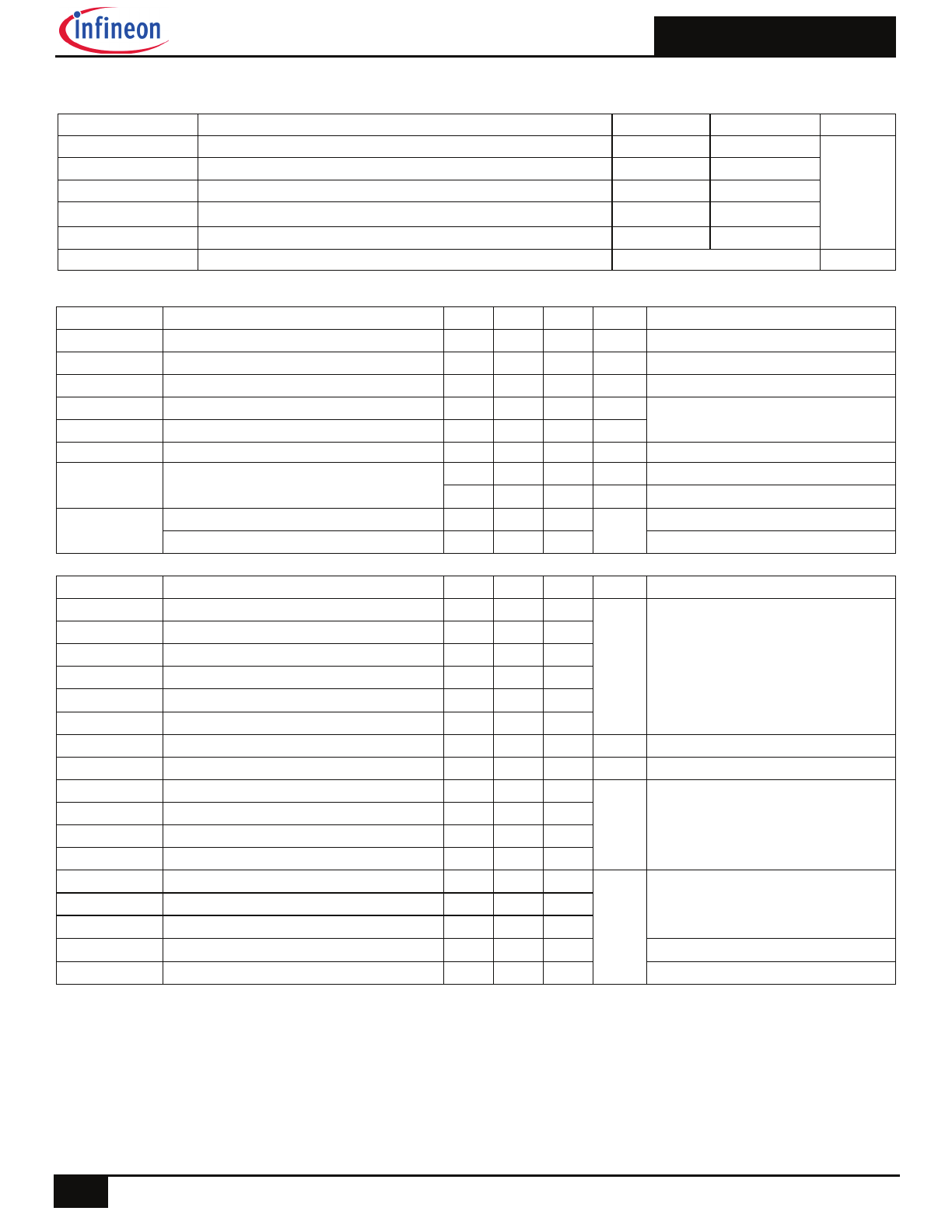
AUIRF7799L2TR
2
2015-10-5
Thermal Resistance
Symbol Parameter
Typ.
Max.
Units
R
JA
Junction-to-Ambient
–––
35
R
JA
Junction-to-Ambient
12.5
–––
R
JA
Junction-to-Ambient
20
–––
R
J-Can
Junction-to-Can –––
1.2
R
J-PCB
Junction-to-PCB Mounted
–––
0.5
Linear Derating Factor 0.83
W/°C
°C/W
Static Electrical Characteristics @ T
J
= 25°C (unless otherwise specified)
Symbol Parameter
Min.
Typ.
Max.
Units
Conditions
V
(BR)DSS
Drain-to-Source Breakdown Voltage
250
–––
–––
V
V
GS
= 0V, I
D
= 250µA
V
(BR)DSS
/
T
J
Breakdown Voltage Temp. Coefficient
––– 0.12 –––
V/°C Reference to 25°C, I
D
= 2.0mA
R
DS(on)
Static Drain-to-Source On-Resistance
––– 32 38 m V
GS
= 10V, I
D
= 21A
V
GS(th)
Gate Threshold Voltage
3.0
4.0
5.0
V
V
DS
= V
GS
, I
D
= 250µA
V
GS(th)
/
T
J
Gate Threshold Voltage Coefficient
–––
-13
––– mV/°C
gfs Forward
Transconductance
54
–––
–––
S
V
DS
= 50V, I
D
= 21A
I
DSS
Drain-to-Source Leakage Current
––– ––– 20 µA V
DS
= 250V, V
GS
= 0V
––– ––– 1
V
DS
= 250V, V
GS
= 0V, T
J
= 125°C
I
GSS
Gate-to-Source Forward Leakage
–––
–––
100
nA
V
GS
= 20V
Gate-to-Source Reverse Leakage
–––
––– -100
V
GS
= -20V
Dynamic Electrical Characteristics @ T
J
= 25°C (unless otherwise specified)
Symbol Parameter
Min.
Typ.
Max.
Units
Conditions
Q
g
Total Gate Charge
–––
110
165
nC
V
DS
= 125V
Q
gs1
Gate-to-Source Charge
–––
26
–––
V
GS
= 10V
Q
gs2
Gate-to-Source
Charge
––– 5.7 –––
I
D
= 21A
Q
gd
Gate-to-Drain ("Miller") Charge
–––
39
See Fig.11
Q
godr
Gate Charge Overdrive
–––
39
–––
Q
sw
Switch Charge (Q
gs2
+ Q
gd
) –––
45
–––
Q
oss
Output Charge
–––
33
–––
nC V
DS
= 16V, V
GS
= 0V
t
d(on)
Turn-On Delay Time
––– 36.3 –––
ns
V
DD
= 125V, V
GS
= 10V
t
r
Rise
Time
––– 33.5 –––
I
D
= 21A
t
d(off)
Turn-Off Delay Time
––– 73.9 –––
R
G
= 6.2
t
f
Fall
Time
––– 26.6 –––
C
iss
Input Capacitance
––– 6714 –––
pF
V
GS
= 0V
C
oss
Output
Capacitance
––– 606 –––
V
DS
= 25V
C
rss
Reverse
Transfer
Capacitance
––– 157 –––
ƒ = 1.0 MHz
C
oss
Output Capacitance
––– 5063 –––
V
GS
= 0V, V
DS
= 1.0V, ƒ = 1.0 MHz
C
oss
Output
Capacitance
––– 217 –––
V
GS
= 0V, V
DS
= 200V, ƒ = 1.0 MHz
R
G
Internal
Gate
Resistance
––– 0.73 –––
mA
Notes through are on page 3

AUIRF7799L2TR
3
2015-10-5
Diode Characteristics
Symbol
Parameter
Min. Typ. Max. Units
Conditions
I
S
Continuous Source Current
––– –––
35
A
MOSFET symbol
(Body Diode)
showing the
I
SM
Pulsed Source Current
––– –––
integral reverse
(Body Diode)
p-n junction diode.
V
SD
Diode Forward Voltage
–––
–––
1.3
V
T
J
= 25°C, I
S
= 21A, V
GS
= 0V
t
rr
Reverse Recovery Time
––– 132 198 ns T
J
= 25°C, I
F
= 21A, V
DD
= 50V
Q
rr
Reverse Recovery Charge
––– 1412 2118 nC dv/dt = 100A/µs
140
Surface mounted on 1 in.
square Cu board (still air).
Mounted on minimum
footprint full size board with
metalized back and with small
clip heatsink (still air).
Mounted to a PCB with
small clip heatsink (still air)
Click on this section to link to the appropriate technical paper.
Click on this section to link to the DirectFET
®
Website.
Surface mounted on 1 in. square Cu board, steady state.
T
C
measured with thermocouple mounted to top (Drain) of part.
Repetitive rating; pulse width limited by max. junction temperature.
Starting T
J
= 25°C, L = 1.42mH, R
G
= 25
, I
AS
= 21A.
Pulse width
400µs; duty cycle 2%.
Used double sided cooling, mounting pad with large heatsink.
Mounted on minimum footprint full size board with metalized back and with small clip heat sink.
R
is measured at T
J
of approximately 90°C.
D
S
G

AUIRF7799L2TR
4
2015-10-5
Fig. 3
Typical On-Resistance vs. Gate Voltage
Fig. 1 Typical Output Characteristics
Fig 5. Typical Transfer Characteristics
Fig 6. Normalized On-Resistance vs. Temperature
Fig. 2 Typical Output Characteristics
0.1
1
10
100
VDS, Drain-to-Source Voltage (V)
0.1
1
10
100
1000
I D
,
D
ra
in
-t
o
-S
o
ur
ce
C
u
rr
en
t (
A
)
VGS
TOP 15V
10V
8.0V
7.0V
6.5V
6.0V
5.5V
BOTTOM
5.0V
60µs PULSE WIDTH
Tj = 25°C
5.0V
0.1
1
10
100
VDS, Drain-to-Source Voltage (V)
0.1
1
10
100
1000
I D
,
D
ra
in
-t
o
-S
o
ur
ce
C
u
rr
en
t (
A
)
VGS
TOP 15V
10V
8.0V
7.0V
6.5V
6.0V
5.5V
BOTTOM
5.0V
60µs PULSE WIDTH
Tj = 175°C
5.0V
4
8
12
16
20
VGS, Gate -to -Source Voltage (V)
20
40
60
80
100
120
140
160
180
200
R
D
S
(o
n
),
D
ra
in
-t
o
-S
ou
rc
e
O
n
R
es
is
ta
nc
e
(m
)
ID = 21A
TJ = 25°C
TJ = 125°C
3
4
5
6
7
VGS, Gate-to-Source Voltage (V)
0.1
1
10
100
1000
I D
, D
ra
in
-t
o-
S
ou
rc
e
C
ur
re
nt
(A
)
TJ = 175°C
TJ = 25°C
TJ = -40°C
VDS = 50V
60µs PULSE WIDTH
0
20
40
60
80
100
ID, Drain Current (A)
25
30
35
40
45
50
55
60
T
yp
ic
al
R
D
S
(o
n)
(
m
)
TJ = 25°C
Vgs = 7.0V
Vgs = 8.0V
Vgs = 10V
Vgs = 15V
-60 -40 -20 0 20 40 60 80 100120140160180
TJ , Junction Temperature (°C)
0.0
0.5
1.0
1.5
2.0
2.5
3.0
R
D
S
(o
n)
,
D
ra
in
-t
o-
S
ou
rc
e
O
n
R
es
is
ta
nc
e
(
N
or
m
al
iz
ed
)
ID = 21A
VGS = 10V
Fig. 4
Typical On-Resistance vs. Drain Current

AUIRF7799L2TR
5
2015-10-5
Fig 11. Typical Gate Charge vs.
Gate-to-Source Voltage
-75 -50 -25 0
25 50 75 100 125 150 175
TJ , Temperature ( °C )
1.0
2.0
3.0
4.0
5.0
6.0
V
G
S
(t
h)
, G
at
e
T
hr
es
ho
ld
V
ol
ta
ge
(
V
)
ID = 250µA
ID = 1.0mA
ID = 1.0A
0.1 0.2 0.3 0.4 0.5 0.6 0.7 0.8 0.9
1
VSD, Source-to-Drain Voltage (V)
0.1
1
10
100
1000
I S
D
, R
ev
er
se
D
ra
in
C
ur
re
nt
(
A
)
TJ = 175°C
TJ = 25°C
TJ = -40°C
VGS = 0V
0
20
40
60
80
100
120
ID,Drain-to-Source Current (A)
0
40
80
120
160
200
G
fs
, F
or
w
ar
d
T
ra
ns
co
nd
uc
ta
nc
e
(S
)
TJ = 25°C
TJ = 175°C
VDS = 50V
20µs PULSE WIDTH
Fig. 7 Typical Threshold Voltage vs.
Junction Temperature
1
10
100
1000
VDS, Drain-to-Source Voltage (V)
100
1000
10000
100000
C
, C
ap
ac
ita
nc
e
(p
F
)
VGS = 0V, f = 1 MHZ
Ciss = Cgs + Cgd, C ds SHORTED
Crss = Cgd
Coss = Cds + Cgd
Coss
Crss
Ciss
Fig 8. Typical Source-Drain Diode Forward Voltage
0
20
40
60
80
100 120 140 160
QG, Total Gate Charge (nC)
0.0
2.0
4.0
6.0
8.0
10.0
12.0
14.0
V
G
S
, G
at
e-
to
-S
ou
rc
e
V
ol
ta
ge
(
V
)
VDS= 200V
VDS= 125V
VDS= 50V
ID= 21A
Fig 9. Typical Forward Trans conductance vs. Drain Current
25
50
75
100
125
150
175
TC , Case Temperature (°C)
0
10
20
30
40
I D
,
D
ra
in
C
ur
re
nt
(
A
)
Fig 12. Maximum Drain Current vs. Case Temperature
Fig 10. Typical Capacitance vs. Drain-to-Source Voltage
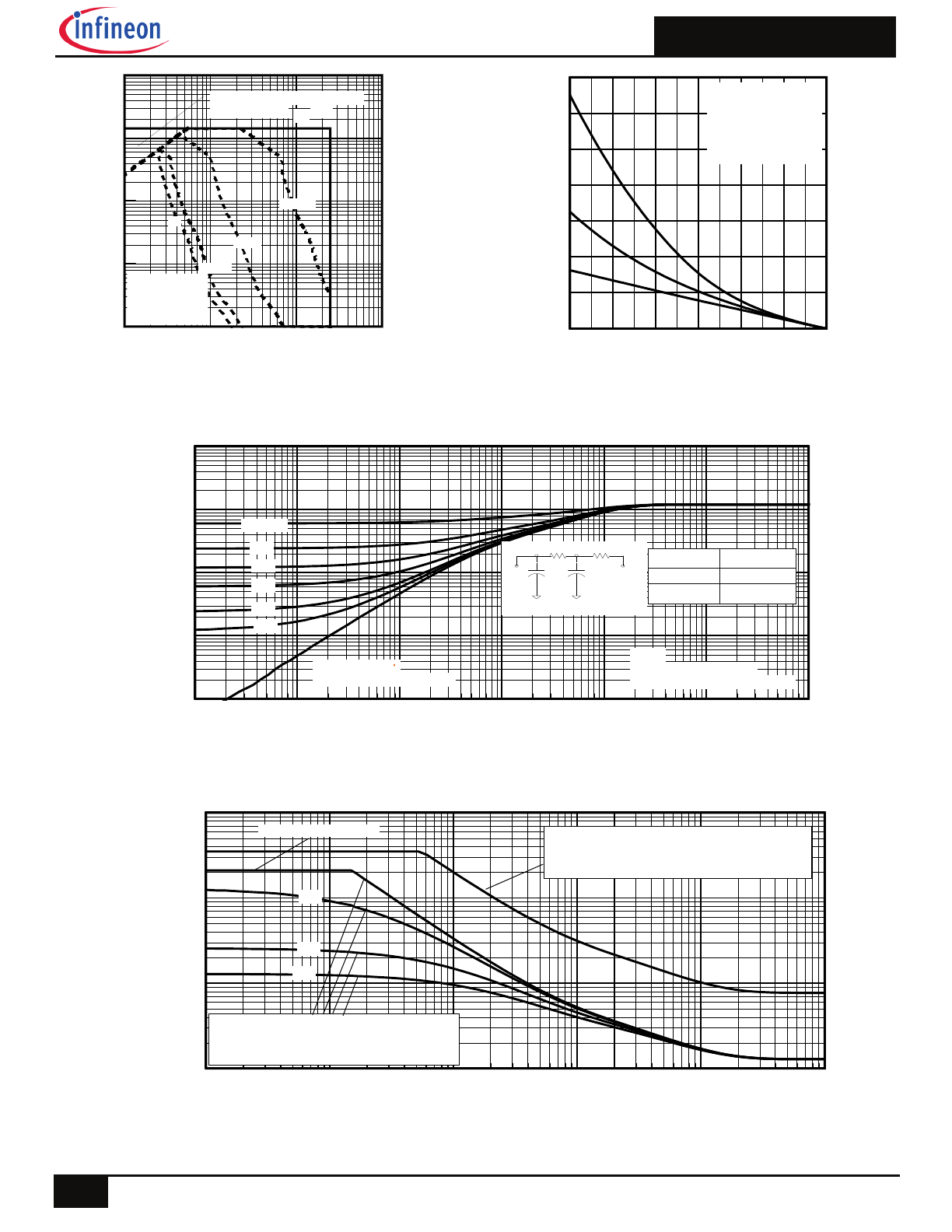
AUIRF7799L2TR
6
2015-10-5
Fig 16. Typical Avalanche Current vs. Pulse Width
Fig 14. Maximum Avalanche Energy vs. Temperature
Fig 13. Maximum Safe Operating Area
1
10
100
1000
VDS, Drain-to-Source Voltage (V)
0.1
1
10
100
1000
I D
,
D
ra
in
-t
o-
S
ou
rc
e
C
ur
re
nt
(
A
)
OPERATION IN THIS AREA
LIMITED BY R DS(on)
Tc = 25°C
Tj = 175°C
Single Pulse
100µsec
1msec
10msec
DC
25
50
75
100
125
150
175
Starting T J , Junction Temperature (°C)
0
200
400
600
800
1000
1200
1400
E
A
S
,
S
in
gl
e
P
ul
se
A
va
la
nc
he
E
ne
rg
y
(m
J)
ID
TOP 1.33A
2.53A
BOTTOM 21A
1E-006
1E-005
0.0001
0.001
0.01
0.1
1
t1 , Rectangular Pulse Duration (sec)
0.001
0.01
0.1
1
10
T
he
rm
al
R
es
po
ns
e
(
Z
th
JC
)
0.20
0.10
D = 0.50
0.02
0.01
0.05
SINGLE PULSE
( THERMAL RESPONSE )
Notes:
1. Duty Factor D = t1/t2
2. Peak Tj = P dm x Zthjc + Tc
Fig 15. Maximum Effective Transient Thermal Impedance, Junction-to-Case
Ri (°C/W)
i (sec)
0.38829
0.000787
0.8117
0.006586
J
J
1
1
2
2
R
1
R
1
R
2
R
2
C
C
Ci=
iRi
Ci=
iRi
1.0E-06
1.0E-05
1.0E-04
1.0E-03
1.0E-02
1.0E-01
tav (sec)
0.1
1
10
100
A
va
la
nc
he
C
ur
re
nt
(
A
)
0.05
Duty Cycle = Single Pulse
0.10
Allowed avalanche Current vs avalanche
pulsewidth, tav, assuming j = 25°C and
Tstart = 150°C.
0.01
Allowed avalanche Current vs avalanche
pulsewidth, tav, assuming Tj = 150°C and
Tstart =25°C (Single Pulse)
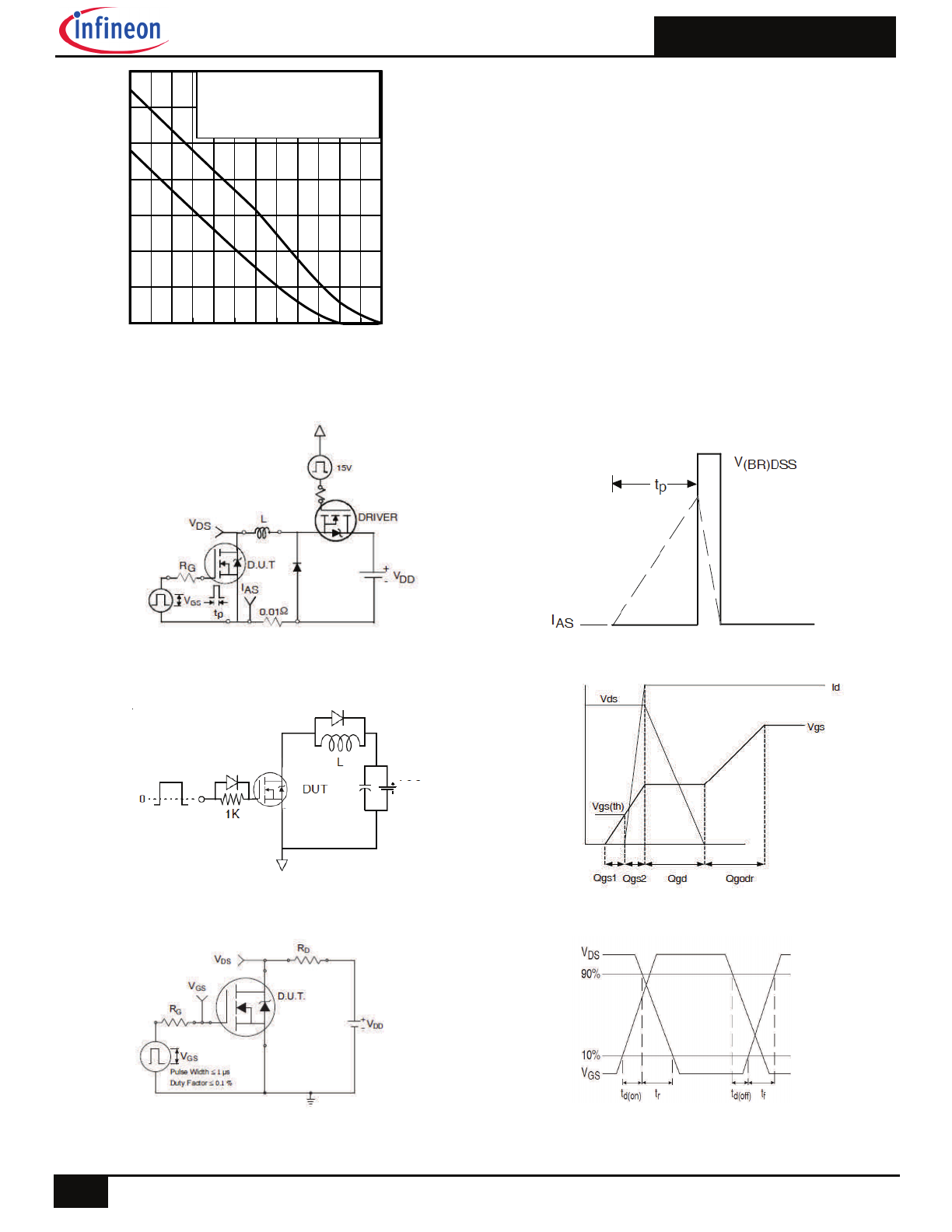
AUIRF7799L2TR
7
2015-10-5
Notes on Repetitive Avalanche Curves , Figures 16, 17:
(For further info, see AN-1005 at www.infineon.com)
1. Avalanche failures assumption:
Purely a thermal phenomenon and failure occurs at a temperature far in
excess of T
jmax
. This is validated for every part type.
2. Safe operation in Avalanche is allowed as long as T
jmax
is not exceeded.
3. Equation below based on circuit and waveforms shown in Figures 18a, 18b.
4. P
D (ave)
= Average power dissipation per single avalanche pulse.
5. BV = Rated breakdown voltage (1.3 factor accounts for voltage increase
during
avalanche).
6. I
av
= Allowable avalanche current.
7.
T
=
Allowable rise in junction temperature, not to exceed
T
jmax
(assumed as
25°C in Figure 16, 17).
t
av =
Average time in avalanche.
D = Duty cycle in avalanche = t
av
·f
Z
thJC
(D, t
av
) = Transient thermal resistance, see Figures 15)
P
D (ave)
= 1/2 ( 1.3·BV·I
av
) =
T/ Z
thJC
I
av
= 2
T/ [1.3·BV·Z
th
]
E
AS (AR)
= P
D (ave)
·t
av
Fig 18a. Unclamped Inductive Test Circuit
Fig 18b. Unclamped Inductive Waveforms
Fig 19a. Gate Charge Test Circuit
Fig 19b. Gate Charge Waveform
VDD
Fig 20a. Switching Time Test Circuit
Fig 20b. Switching Time Waveforms
25
50
75
100
125
150
175
Starting TJ , Junction Temperature (°C)
0
50
100
150
200
250
300
350
E
A
R
,
A
va
la
nc
he
E
ne
rg
y
(m
J)
TOP Single Pulse
BOTTOM 1.0% Duty Cycle
ID = 21A
Fig 17. Maximum Avalanche Energy vs. Temperature
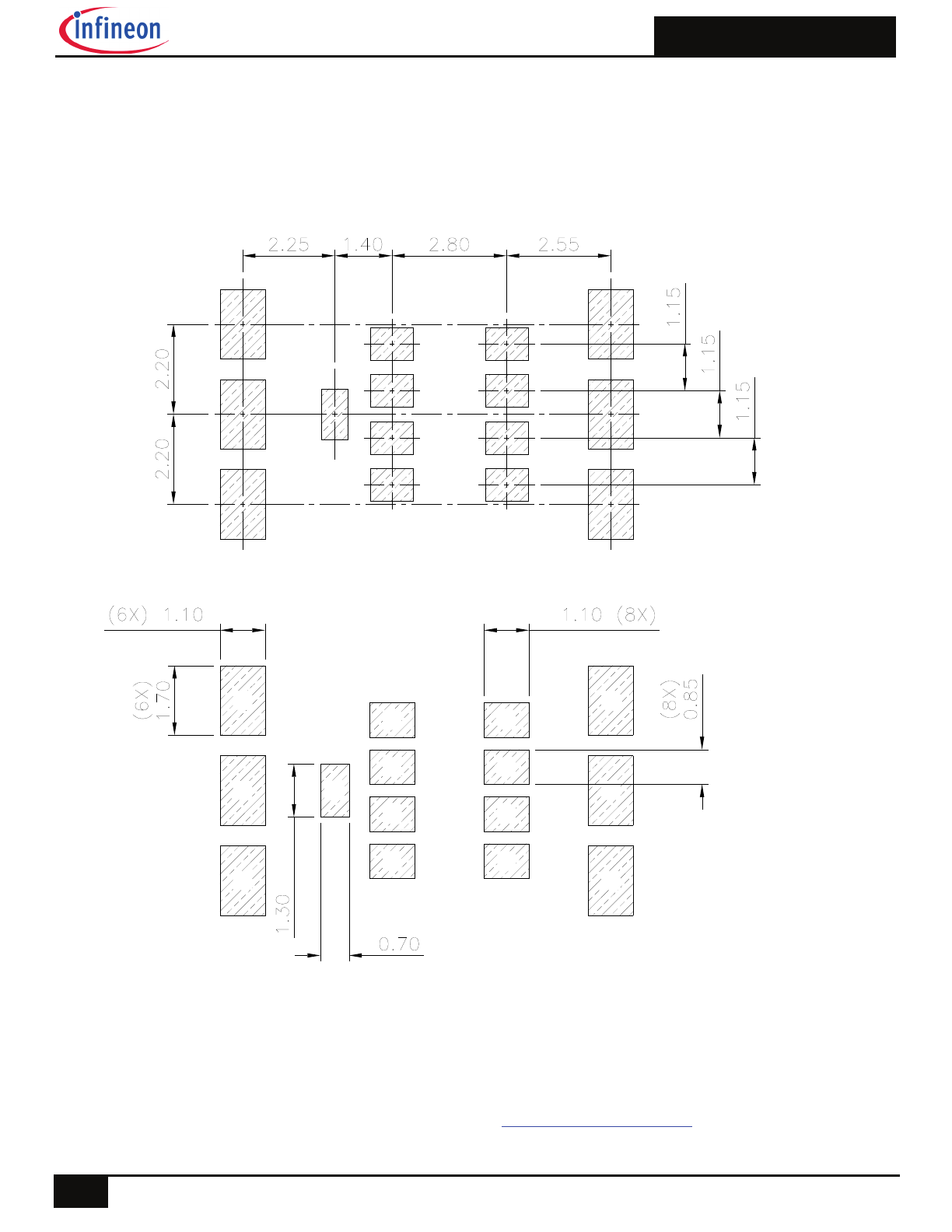
AUIRF7799L2TR
8
2015-10-5
DirectFET
®
Board Footprint, L8 (Large Size Can).
Please see DirectFET
®
application note AN-1035 for all details regarding the assembly of DirectFET
®
.
This includes all recommendations for stencil and substrate designs.
G = GATE
D = DRAIN
S = SOURCE
G
D
D
D
D
D
D
S
S
S
S
S
S
S
S
Note: For the most current drawing please refer to IR website at
http://www.irf.com/package/
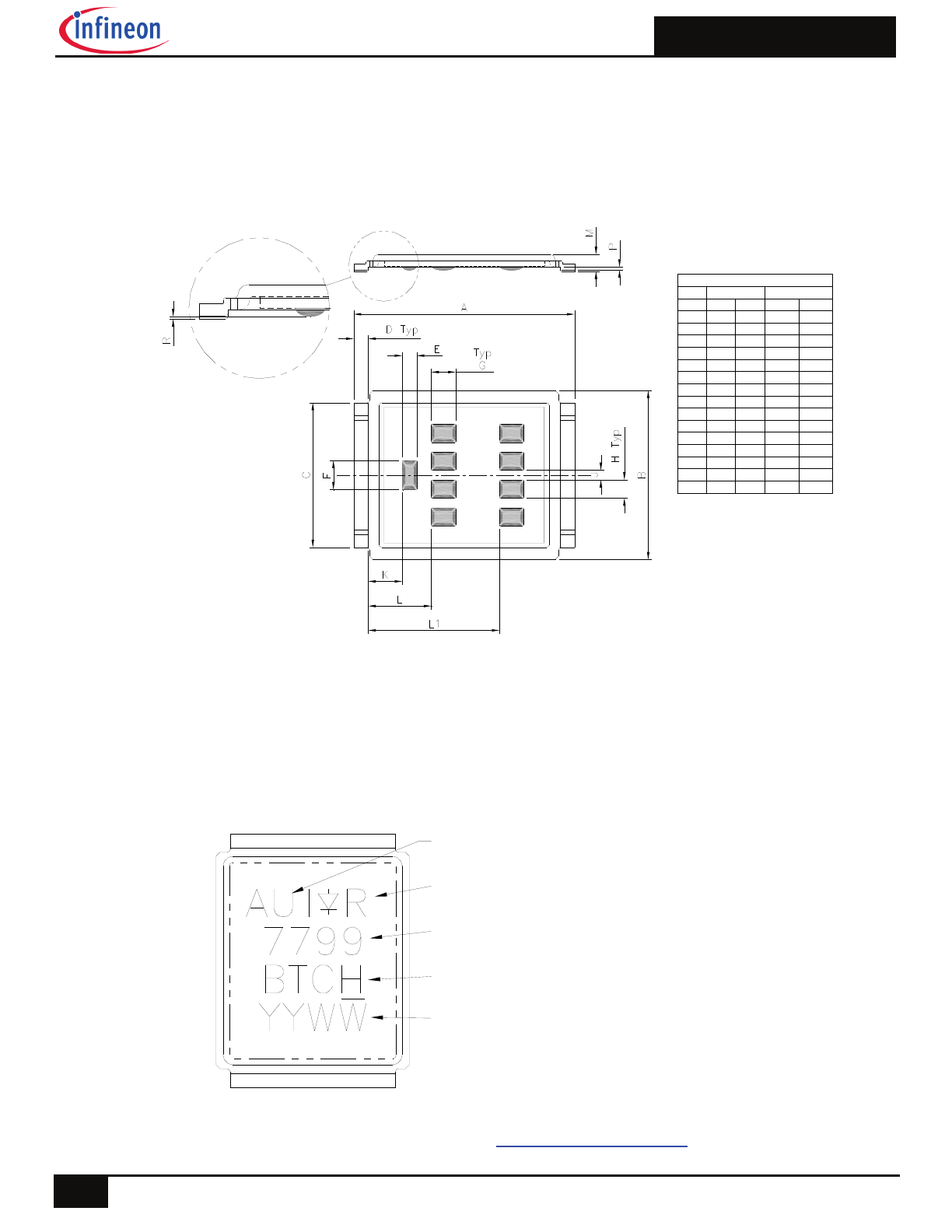
AUIRF7799L2TR
9
2015-10-5
DirectFET
®
Outline Dimension, L8 (Large Size Can).
Please see DirectFET
®
application note AN-1035 for all details regarding the assembly of DirectFET
®
. This includes
all recommendations for stencil and substrate designs.
DirectFET
®
Part Marking
"AU" = GATE AND
AUTOMOTIVE MARKING
PART NUMBER
LOGO
BATCH NUMBER
DATE CODE
Line above the last character of
the date code indicates "Lead-Free"
CODE
A
B
C
D
E
F
G
H
J
K
L
M
R
P
0.017
0.029
0.003
0.007
0.057
0.104
0.236
0.048
0.026
0.024
MAX
0.360
0.280
0.38
0.68
0.02
0.09
1.35
2.55
5.90
1.18
0.55
0.58
MIN
9.05
6.85
0.42
0.74
0.08
0.17
1.45
2.65
6.00
1.22
0.65
0.62
MAX
9.15
7.10
0.015
0.027
0.003
0.001
0.100
0.053
0.232
0.046
0.023
0.022
MIN
0.270
0.356
METRIC
IMPERIAL
DIMENSIONS
0.98
1.02
0.73
0.77
0.040
0.039
0.030
0.029
L1
0.215
5.35
5.45
0.211
Note: For the most current drawing please refer to IR website at
http://www.irf.com/package/
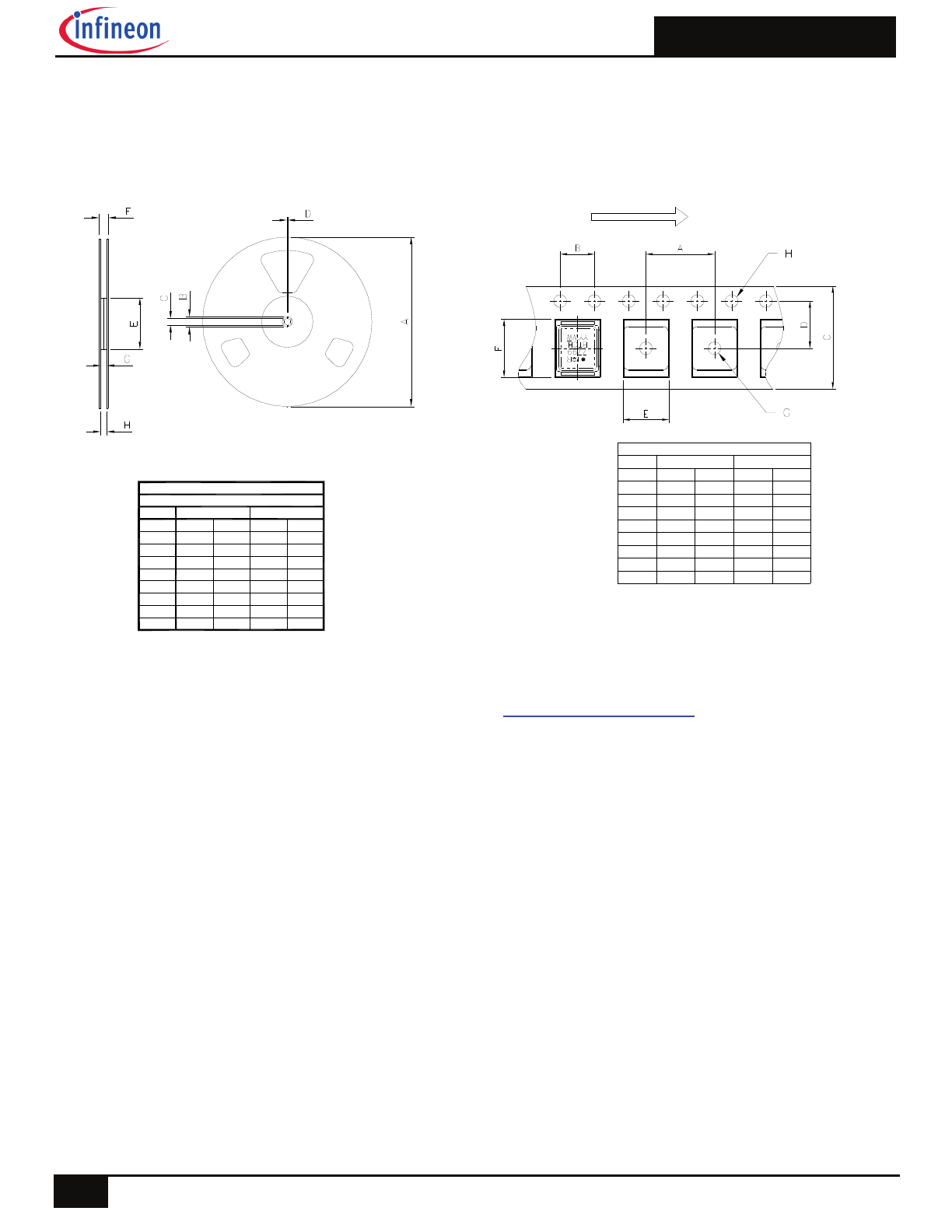
AUIRF7799L2TR
10
2015-10-5
DirectFET
®
Tape & Reel Dimension (Showing component orientation)
LOADED TAPE FEED DIRECTION
NOTE: CONTROLLING
DIMENSIONS IN MM
CODE
A
B
C
D
E
F
G
H
IMPERIAL
MIN
4.69
0.154
0.623
0.291
0.283
0.390
0.059
0.059
MAX
12.10
4.10
16.30
7.60
7.40
10.10
N.C
1.60
MIN
11.90
3.90
15.90
7.40
7.20
9.90
1.50
1.50
METRIC
DIMENSIONS
MAX
0.476
0.161
0.642
0.299
0.291
0.398
N.C
0.063
REEL DIMENSIONS
NOTE: Controlling dimensions in mm
Std reel quantity is 4000 parts, ordered as AUIRF7799L2TR.
MAX
N.C
N.C
0.520
N.C
3.940
0.880
0.720
0.760
IMPERIAL
MIN
330.00
20.20
12.80
1.50
99.00
N.C
16.40
15.90
STANDARD OPTION (QTY 4000)
CODE
A
B
C
D
E
F
G
H
MAX
N.C
N.C
13.20
N.C
100.00
22.40
18.40
19.40
MIN
12.992
0.795
0.504
0.059
3.900
N.C
0.650
0.630
METRIC
Note: For the most current drawing please refer to IR website at
http://www.irf.com/package/
